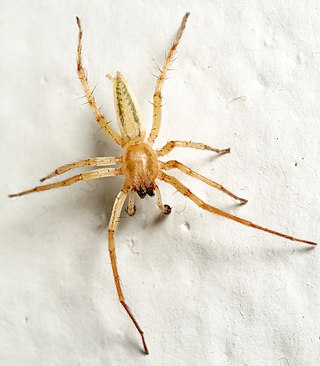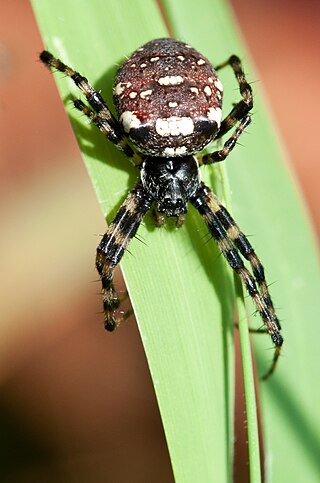
Anyphaenidae is a family of araneomorph spiders, sometimes called anyphaenid sac spiders or ghost spiders. They are distinguished from the sac spiders of the family Clubionidae and other spiders by having the abdominal spiracle placed one third to one half of the way anterior to the spinnerets toward the epigastric furrow on the underside of the abdomen. In most spiders the spiracle is just anterior to the spinnerets.

Amaurobiidae is a family of three-clawed cribellate or ecribellate spiders found in crevices and hollows or under stones where they build retreats, and are often collected in pitfall traps. Unlidded burrows are sometimes quite obvious in crusty, loamy soil. They are difficult to distinguish from related spiders in other families, especially Agelenidae, Desidae and Amphinectidae. Their intra- and interfamilial relationships are contentious. According to the World Spider Catalog, 2023, the family Amaurobiidae includes 286 species in 50 genera.

The spider genus Steatoda, in the family Theridiidae, includes about 120 recognized species, distributed around the world. One common name is cupboard spider, for many species build their webs in dark, sheltered, undisturbed places around the house or garden, in sheds and garages, under garden, in compost bins, and the like. Signs of the cupboard spider include small white spots of spider droppings, like small splashes of paint, on the floor underneath the web.

Nemesiidae is a family of mygalomorph spiders first described by Eugène Simon in 1889, and raised to family status in 1985. Before becoming its own family, it was considered part of "Dipluridae". The family is sometimes referred to as wishbone spiders due to the shape of their burrows.

Gea is a genus of orb-weaver spiders first described by C. L. Koch in 1843.
Laminacauda is a genus of dwarf spiders that was first described by Alfred Frank Millidge in 1985.
Laminacauda plagiata is a species of sheet weaver found in Argentina, Chile and the Falkland Islands. It was described by Tullgren in 1901.

Hugo Albert Tullgren was a Swedish entomologist and arachnologist.
Hicanodon is a genus of South American tangled nest spiders containing the single species, Hicanodon cinerea. It was first described by Albert Tullgren in 1901, and has only been found in Chile and Argentina.
Macrobunus is a genus of tangled nest spiders first described by Albert Tullgren in 1901.
Acanthoceto is a genus of South American anyphaenid sac spiders first described by Cândido Firmino de Mello-Leitão in 1944.
Aysenia is a genus of South American anyphaenid sac spiders first described by Albert Tullgren in 1902.

Dresserus is a genus of African velvet spiders that was first described by Eugène Simon in 1876.
Scotinoecus is a genus of South American funnel-web spiders that was first described by Eugène Louis Simon in 1892. Originally placed with the curtain web spiders, it was moved to the Hexathelidae in 1980.
Diphya is a genus of long-jawed orb-weavers that was first described by H. Nicolet in 1849. D. tanasevitchi and D. albulum were transferred from Lophomma in 2007.
Acantharachne is a genus of African orb-weaver spiders first described by Albert Tullgren in 1910.
Neomaso is a genus of dwarf spiders that was first described by Raymond Robert Forster in 1970.
Notholepthyphantes is a genus of South American dwarf spiders that was first described by Alfred Frank Millidge in 1985.
Notiohyphantes is a genus of dwarf spiders that was first described by Alfred Frank Millidge in 1985.

Allende is a genus of South American long-jawed orb-weavers that was first described by F. Álvarez-Padilla in 2007.







